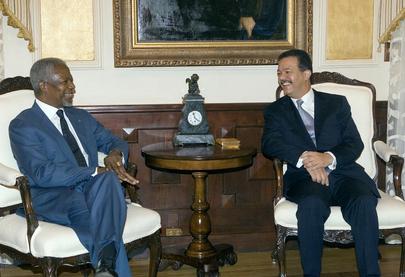|
|
|
Second Pilot Country: DOMINICAN REPUBLIC |
Briefing Note
|
"We believe that
by multiplying our efforts, highlighting synergies, and harnessing
the goodwill of the public and private sectors, we will
be able to achieve the Goals"
::Quoted
from the President of Dominican Republic at the 2005 World Summit 14
September 2005:: |

|
Click here to view the brochure for more information
(English)
|

Secretary-General Kofi Annan (left) visiting
President Leonel Fernández Reyna,
Santo Domingo, Dominican Republic, 04 August 2006 (UN Photo: Eskinder Debebe)
Background:
|
The
Dominican Republic, a Caribbean representative democracy, occupies the eastern
two-thirds of the island of Hispaniola and has a population that totals nearly
9.2 million.
The country has valuable
natural resources – nickel, bauxite, gold and silver. However, the country is
primarily dependent on tourism and related services and the exportation of goods
for robust economic expansion. Investment in the burgeoning tourism industry is
the source of most U.S. foreign direct investment in the country, which reached
US$1 billion in 2004. Dominicans’ export portfolio consists of the country’s
traditional agriculture products – sugar, coffee and tobacco – and
free-trade-zone manufactured products, including amongst other goods garments
and footwear. Though, it is important to note that remittances to the
Dominican Republic – totaling US$ 2.7 billion in 2004 – have the potential to be
a catalyst for sustainable growth and development in future years.
Tourism and the rest of the
service industry (including financial services) is the country’s economic engine
– accounting for 61 percent of Gross Domestic Product (GDP) growth and employing
nearly as large a portion of the population (60 percent). The sector’s strong
performance in recent years is largely responsible for the astounding 9.3
percent increase in GDP in 2005. Yet the country suffers from persistent income
inequality: the wealthiest 10 percent of the population owns almost 40 percent
of national wealth, while the bottom half receives less than one-fifth of Gross
National Product (GNP).
Rural development is a
critical concern because rural Dominicans feel the brunt of the country’s income
disparities. Additionally, though agriculture is the strength of the rural
economy – employing the majority of the rural poor – inadequate rural
infrastructure, vulnerability to changes in the international price for
agriculture commodities and natural disasters (hurricanes) jeopardizes
agriculture production, hindering consistent rural economic performance.
Consequently, reduction in rural poverty levels is critical to the fulfillment
of the internationally agreed development goals, including the Millennium
Development Goals.
(The note
above is from the UN
Department of Public Information) |
Programme
Priorities:
The
Presidential
Commission on the MDGs and Sustainable Development (COPDES),
the country-level implementing mechanism, works for poverty reduction
through:
-
Infrastructure building, (roads, bridges,
etc);
-
Safe water and hygiene;
-
Agro-business;
-
Mining;
-
Textile, garments and handicrafts;
-
Tourism;
-
Development of SMEs (small and medium-sized
enterprises) and financial sectors;
-
Information and communication technology (ICT);
-
Energy and sanitation and
-
Attracting remittances, foreign direct investments and
foreign trade.
|
New York Mission:
Permanent Mission of the Dominican Republic to the United Nations
144 East 44th Street, 4th Floor
New York, N.Y. 10017 USA
Telephone: 212-867-0833
Fax: 212-986-4694
|
Copyright 2004
© United Nations
Public-Private Alliance for Rural Development |
|

